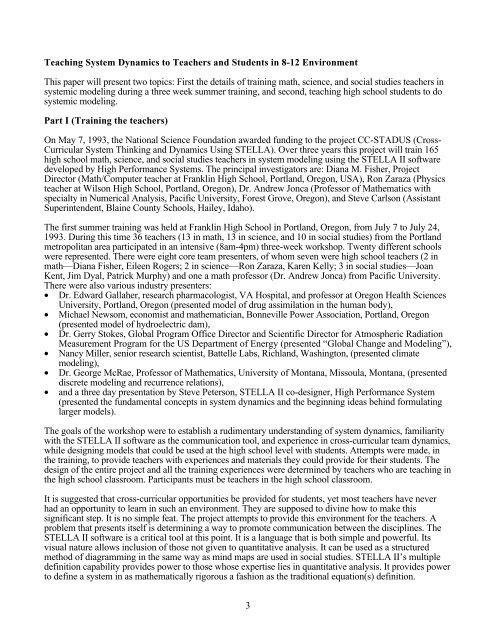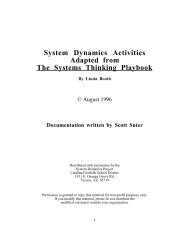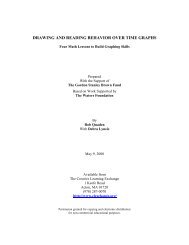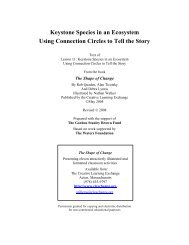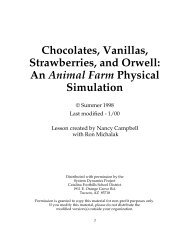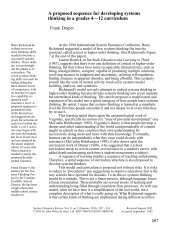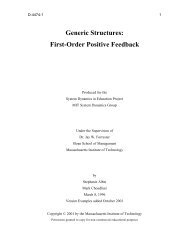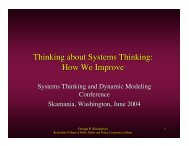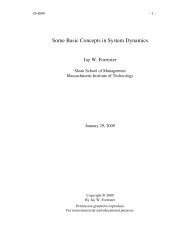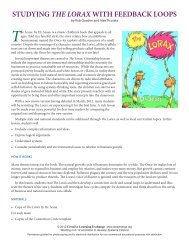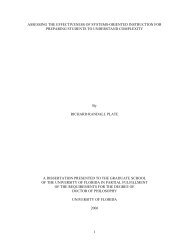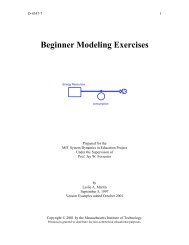Teaching System Dynamics to Teachers and Students in 8-12 ...
Teaching System Dynamics to Teachers and Students in 8-12 ...
Teaching System Dynamics to Teachers and Students in 8-12 ...
You also want an ePaper? Increase the reach of your titles
YUMPU automatically turns print PDFs into web optimized ePapers that Google loves.
<strong>Teach<strong>in</strong>g</strong> <strong>System</strong> <strong>Dynamics</strong> <strong>to</strong> <strong>Teachers</strong> <strong>and</strong> <strong>Students</strong> <strong>in</strong> 8-<strong>12</strong> EnvironmentThis paper will present two <strong>to</strong>pics: First the details of tra<strong>in</strong><strong>in</strong>g math, science, <strong>and</strong> social studies teachers <strong>in</strong>systemic model<strong>in</strong>g dur<strong>in</strong>g a three week summer tra<strong>in</strong><strong>in</strong>g, <strong>and</strong> second, teach<strong>in</strong>g high school students <strong>to</strong> dosystemic model<strong>in</strong>g.Part I (Tra<strong>in</strong><strong>in</strong>g the teachers)On May 7, 1993, the National Science Foundation awarded fund<strong>in</strong>g <strong>to</strong> the project CC-STADUS (Cross-Curricular <strong>System</strong> Th<strong>in</strong>k<strong>in</strong>g <strong>and</strong> <strong>Dynamics</strong> Us<strong>in</strong>g STELLA). Over three years this project will tra<strong>in</strong> 165high school math, science, <strong>and</strong> social studies teachers <strong>in</strong> system model<strong>in</strong>g us<strong>in</strong>g the STELLA II softwaredeveloped by High Performance <strong>System</strong>s. The pr<strong>in</strong>cipal <strong>in</strong>vestiga<strong>to</strong>rs are: Diana M. Fisher, ProjectDirec<strong>to</strong>r (Math/Computer teacher at Frankl<strong>in</strong> High School, Portl<strong>and</strong>, Oregon, USA), Ron Zaraza (Physicsteacher at Wilson High School, Portl<strong>and</strong>, Oregon), Dr. Andrew Jonca (Professor of Mathematics withspecialty <strong>in</strong> Numerical Analysis, Pacific University, Forest Grove, Oregon), <strong>and</strong> Steve Carlson (AssistantSuper<strong>in</strong>tendent, Bla<strong>in</strong>e County Schools, Hailey, Idaho).The first summer tra<strong>in</strong><strong>in</strong>g was held at Frankl<strong>in</strong> High School <strong>in</strong> Portl<strong>and</strong>, Oregon, from July 7 <strong>to</strong> July 24,1993. Dur<strong>in</strong>g this time 36 teachers (13 <strong>in</strong> math, 13 <strong>in</strong> science, <strong>and</strong> 10 <strong>in</strong> social studies) from the Portl<strong>and</strong>metropolitan area participated <strong>in</strong> an <strong>in</strong>tensive (8am-4pm) three-week workshop. Twenty different schoolswere represented. There were eight core team presenters, of whom seven were high school teachers (2 <strong>in</strong>math—Diana Fisher, Eileen Rogers; 2 <strong>in</strong> science—Ron Zaraza, Karen Kelly; 3 <strong>in</strong> social studies—JoanKent, Jim Dyal, Patrick Murphy) <strong>and</strong> one a math professor (Dr. Andrew Jonca) from Pacific University.There were also various <strong>in</strong>dustry presenters:• Dr. Edward Gallaher, research pharmacologist, VA Hospital, <strong>and</strong> professor at Oregon Health SciencesUniversity, Portl<strong>and</strong>, Oregon (presented model of drug assimilation <strong>in</strong> the human body),• Michael Newsom, economist <strong>and</strong> mathematician, Bonneville Power Association, Portl<strong>and</strong>, Oregon(presented model of hydroelectric dam),• Dr. Gerry S<strong>to</strong>kes, Global Program Office Direc<strong>to</strong>r <strong>and</strong> Scientific Direc<strong>to</strong>r for Atmospheric RadiationMeasurement Program for the US Department of Energy (presented “Global Change <strong>and</strong> Model<strong>in</strong>g”),• Nancy Miller, senior research scientist, Battelle Labs, Richl<strong>and</strong>, Wash<strong>in</strong>g<strong>to</strong>n, (presented climatemodel<strong>in</strong>g),• Dr. George McRae, Professor of Mathematics, University of Montana, Missoula, Montana, (presenteddiscrete model<strong>in</strong>g <strong>and</strong> recurrence relations),• <strong>and</strong> a three day presentation by Steve Peterson, STELLA II co-designer, High Performance <strong>System</strong>(presented the fundamental concepts <strong>in</strong> system dynamics <strong>and</strong> the beg<strong>in</strong>n<strong>in</strong>g ideas beh<strong>in</strong>d formulat<strong>in</strong>glarger models).The goals of the workshop were <strong>to</strong> establish a rudimentary underst<strong>and</strong><strong>in</strong>g of system dynamics, familiaritywith the STELLA II software as the communication <strong>to</strong>ol, <strong>and</strong> experience <strong>in</strong> cross-curricular team dynamics,while design<strong>in</strong>g models that could be used at the high school level with students. Attempts were made, <strong>in</strong>the tra<strong>in</strong><strong>in</strong>g, <strong>to</strong> provide teachers with experiences <strong>and</strong> materials they could provide for their students. Thedesign of the entire project <strong>and</strong> all the tra<strong>in</strong><strong>in</strong>g experiences were determ<strong>in</strong>ed by teachers who are teach<strong>in</strong>g <strong>in</strong>the high school classroom. Participants must be teachers <strong>in</strong> the high school classroom.It is suggested that cross-curricular opportunities be provided for students, yet most teachers have neverhad an opportunity <strong>to</strong> learn <strong>in</strong> such an environment. They are supposed <strong>to</strong> div<strong>in</strong>e how <strong>to</strong> make thissignificant step. It is no simple feat. The project attempts <strong>to</strong> provide this environment for the teachers. Aproblem that presents itself is determ<strong>in</strong><strong>in</strong>g a way <strong>to</strong> promote communication between the discipl<strong>in</strong>es. TheSTELLA II software is a critical <strong>to</strong>ol at this po<strong>in</strong>t. It is a language that is both simple <strong>and</strong> powerful. Itsvisual nature allows <strong>in</strong>clusion of those not given <strong>to</strong> quantitative analysis. It can be used as a structuredmethod of diagramm<strong>in</strong>g <strong>in</strong> the same way as m<strong>in</strong>d maps are used <strong>in</strong> social studies. STELLA II’s multipledef<strong>in</strong>ition capability provides power <strong>to</strong> those whose expertise lies <strong>in</strong> quantitative analysis. It provides power<strong>to</strong> def<strong>in</strong>e a system <strong>in</strong> as mathematically rigorous a fashion as the traditional equation(s) def<strong>in</strong>ition.3


